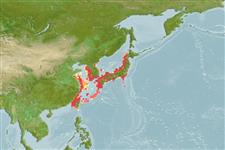Common names from other countries
>
Tetraodontiformes (Puffers and filefishes) >
Tetraodontidae (Puffers) > Tetraodontinae
Etymology: Takifugu: A Japanese word with several meanings; taki = waterfall + fugu = fish; it could be also understood as taki = to be cooked in liquid + fugu = a venomous fish.
More on authors: Temminck & Schlegel.
Environment: milieu / climate zone / depth range / distribution range
Ökologie
seewasser; süßwasser; brackwasser demersal; standorttreu. Temperate; 46°N - 21°N, 119°E - 142°E
Northwest Pacific: western part of the Sea of Japan and the East China and Yellow seas northward to Muroran, Hokkaido, Japan.
Size / Gewicht / Alter
Maturity: Lm ? range ? - ? cm
Max length : 80.0 cm TL Männchen/unbestimmt; (Ref. 56527); common length : 40.0 cm TL Männchen/unbestimmt; (Ref. 637)
Rückenflossenstacheln (insgesamt): 0; Rückenflossenweichstrahlen (insgesamt): 16-19; Afterflossenstacheln 0; Afterflossenweichstrahlen: 13 - 16; Wirbelzahl: 21 - 22. Body covered with prickles; presence of a large round black blotch edged with a white line on side just behind pectoral fin (Ref. 559).
Adults are found in inlet waters, occasionally entering brackish waters. Fingerlings are often seen in brackish river mouths (Ref. 58920). Move offshore with growth. Breed in the sea (Ref. 58920) from March to May; attach eggs to rocks in shingly areas at depths of around 20 m. Liver and ovaries extremely toxic, intestines slightly toxic; flesh, skin and testes not poisonous. Juveniles resemble Takifugu niphobles (Ref. 637). A prized food fish in Japan. Said to be commercially cultured in Japan at present. Used in Chinese medicine (Ref. 12166). One of the first vertebrates whose genome has been sequenced completely, 31,059 genes coding for 33,609 proteins (Ref. 58917).
Life cycle and mating behavior
Geschlechtsreife | Fortpflanzung | Ablaichen | Eier | Fecundity | Larven
Masuda, H., K. Amaoka, C. Araga, T. Uyeno and T. Yoshino, 1984. The fishes of the Japanese Archipelago. Vol. 1. Tokai University Press, Tokyo, Japan. 437 p. (text). (Ref. 559)
IUCN Rote Liste Status (Ref. 130435)
CITES (Ref. 128078)
Not Evaluated
Bedrohung für Menschen
Poisonous to eat (Ref. 637)
Nutzung durch Menschen
Fischereien: hoch kommerziell; Aquakultur: kommerziell
Tools
Zusatzinformationen
Download XML
Internet Quellen
Estimates based on models
Preferred temperature (Ref.
115969): 13.5 - 23, mean 19 (based on 96 cells).
Phylogenetic diversity index (Ref.
82804): PD
50 = 0.5000 [Uniqueness, from 0.5 = low to 2.0 = high].
Bayesian length-weight: a=0.01622 (0.00723 - 0.03638), b=2.92 (2.74 - 3.10), in cm Total Length, based on LWR estimates for this (Sub)family-body shape (Ref.
93245).
Trophic level (Ref.
69278): 3.6 ±0.57 se; based on food items.
Widerstandsfähigkeit (Ref.
120179): mittel, Verdopplung der Population dauert 1,4 - 4,4 Jahre. (K=0.15-0.17; assuming tm<5).
Fishing Vulnerability (Ref.
59153): Low to moderate vulnerability (30 of 100).
